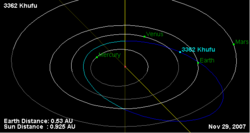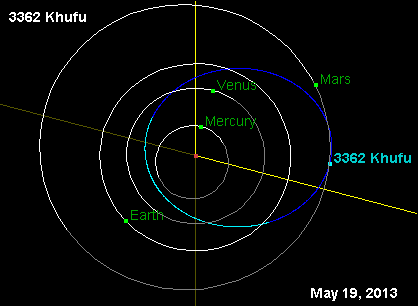3362 Khufu
Topic: Astronomy
 From HandWiki - Reading time: 2 min
From HandWiki - Reading time: 2 min
 3362 Khufu on 29 November 2007 Khufu takes about 359.47 days to orbit the Sun.[1] | |
| Discovery | |
|---|---|
| Discovered by | R. S. Dunbar M. A. Barucci |
| Discovery site | Palomar |
| Discovery date | 30 August 1984 |
| Designations | |
| (3362) Khufu | |
| Pronunciation | /ˈkuːfuː/[2] |
| Minor planet category | PHA[1] |
| Orbital characteristics[1] | |
| Epoch 13 January 2016 (JD 2457400.5) | |
| Uncertainty parameter 0 | |
| Observation arc | 7394 days (20.24 yr) |
| |{{{apsis}}}|helion}} | 1.4531 astronomical unit|AU (217.38 Gm) |
| |{{{apsis}}}|helion}} | 0.52589 AU (78.672 Gm) |
| 0.98951 AU (148.029 Gm) | |
| Eccentricity | 0.46853 |
| Orbital period | 0.98 yr (359.5 d) |
| Mean anomaly | 35.759° |
| Mean motion | 1.0013°/day |
| Inclination | 9.9173° |
| Longitude of ascending node | 152.45° |
| 55.035° | |
| Earth MOID | 0.0130121 AU (1.94658 Gm) |
| Physical characteristics | |
| Dimensions | 0.7 km[1] |
| Mean radius | 0.35 km |
| Geometric albedo | 0.21[1][3] |
| B-type asteroid[4] | |
| Absolute magnitude (H) | 18.3[1] |
3362 Khufu is a near-Earth asteroid. It was discovered by R. Scott Dunbar and Maria A. Barucci at the Palomar Observatory in San Diego County, California, on 30 August 1984. Its provisional designation was 1984 QA. It is named after Khufu, an ancient Egyptian pharaoh. Khufu was the 4th Aten asteroid to be numbered.
3362 Khufu is a potentially hazardous asteroid (PHA) because its minimum orbit intersection distance (MOID) is less than 0.05 AU and its diameter is greater than 150 meters. The Earth-MOID is 0.0135 astronomical unit|AU (2,020,000 km; 1,250,000 mi).[1] Its orbit is well-determined for the next several hundred years.
Khufu crosses the orbits of Mars, Earth, and Venus and makes close approaches to Mercury as well. From 1900 to 2100 it drew nearer than 30 Gm (0.2 AU) to Mercury 26, Venus 27, Earth 20, and Mars 11 times.
Orbit
See also
- Venus-crosser asteroid
- Mars-crosser asteroid
References
- ↑ 1.0 1.1 1.2 1.3 1.4 1.5 "JPL Small-Body Database Browser: 3362 Khufu (1984 QA)". Jet Propulsion Laboratory. https://ssd.jpl.nasa.gov/sbdb.cgi?sstr=Khufu;cad=1.
- ↑ "Khufu". Khufu. Oxford University Press. http://www.lexico.com/definition/Khufu.
- ↑ Hazards due to Comets and Asteroids (1994), Ed. T. Gehrels, pp. 540–543
- ↑ based on a high-resolution spectrum by Xu et al. (1995) or Bus and Binzel (2002)
External links
- calculations by SOLEX
- 3362 Khufu at NeoDyS-2, Near Earth Objects—Dynamic Site
- Ephemeris · Obs prediction · Orbital info · MOID · Proper elements · Obs info · Close · Physical info · NEOCC
- 3362 Khufu at ESA–space situational awareness
- 3362 Khufu at the JPL Small-Body Database
 |
 KSF
KSF
